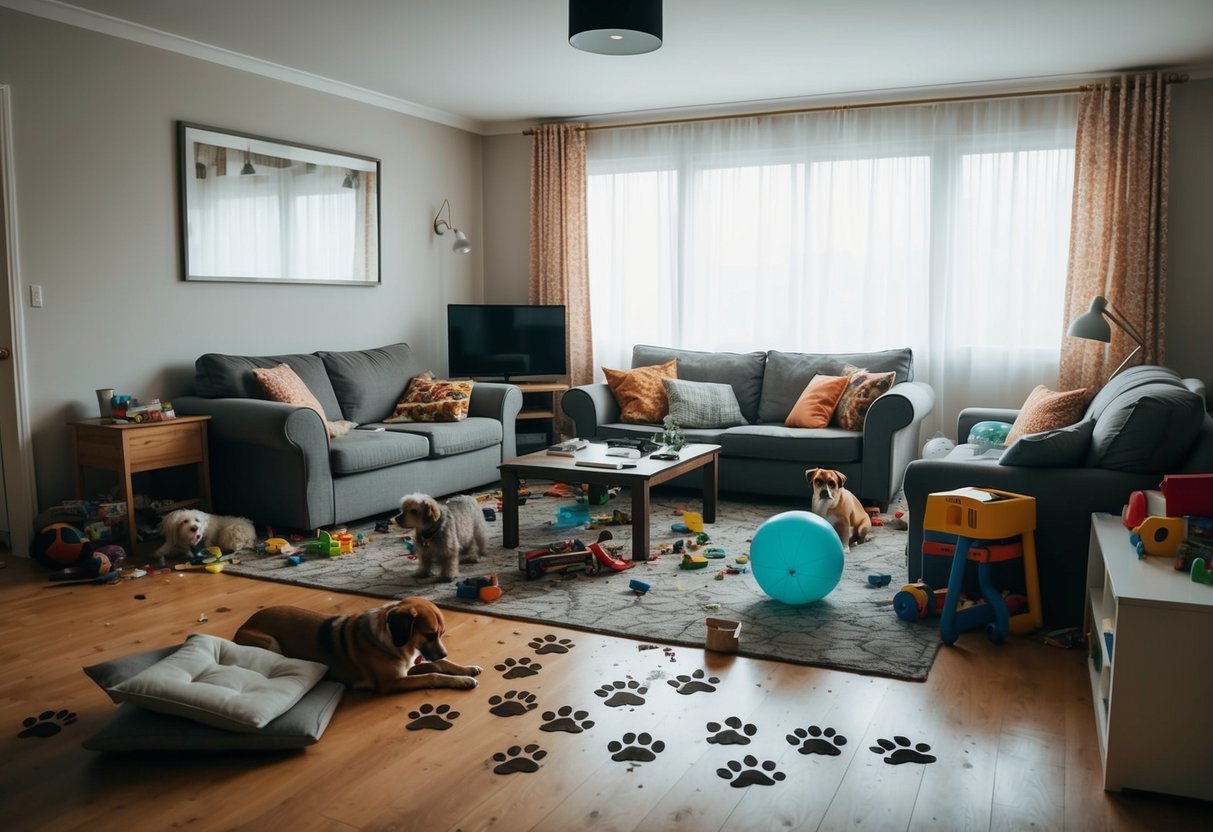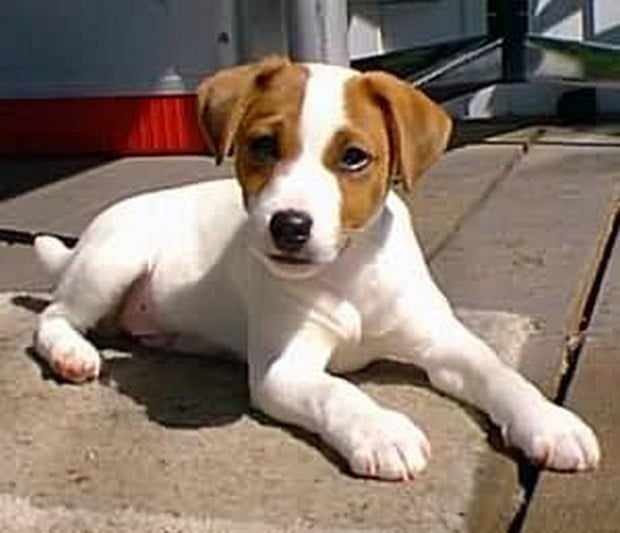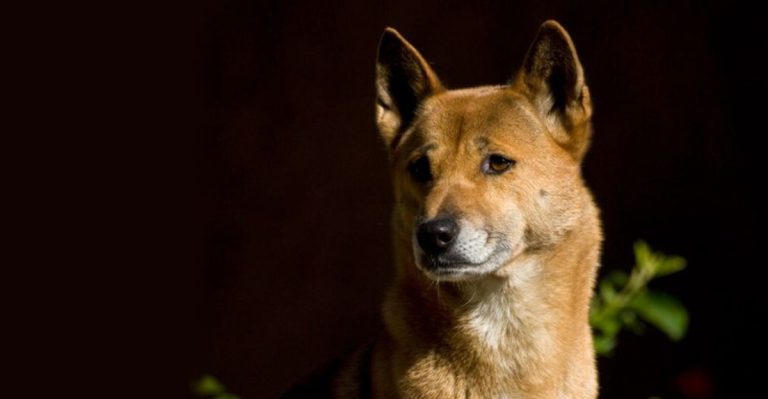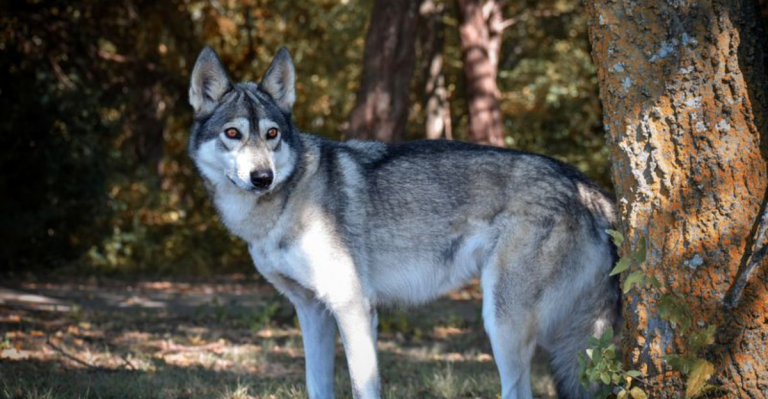20 Worst Dog Breeds for Maintaining a Clean Home: Shedding and Slobbering Culprits

As a dog owner, I know that keeping a clean home can be challenging with certain breeds.
Some dogs are naturally messier or require more grooming, which can impact household cleanliness.
I’ve researched the breeds that tend to be most difficult when it comes to maintaining a tidy living space.
This article will explore 20 dog breeds that may pose extra challenges for neat freaks.
I’ll examine factors like shedding, drooling, tracking in dirt, and other habits that can quickly undo your cleaning efforts.
My goal is to provide helpful information for prospective owners to consider before bringing home a new furry friend.
1. Bulldog

Bulldogs are adorable, but they can be challenging when it comes to maintaining a clean home. I’ve found that their short, dense coat sheds more than one might expect. Loose fur tends to cling to furniture and carpets, requiring frequent vacuuming.
Their facial wrinkles need regular cleaning to prevent skin irritations and unpleasant odors. In my experience, Bulldogs are prone to drooling, which can leave wet spots on floors and furniture.
These dogs often struggle with flatulence, which can lead to occasional unpleasant smells in the house. Their brachycephalic (flat-faced) nature sometimes causes breathing difficulties, resulting in snoring and snorting that can spread saliva around their resting areas.
I’ve noticed that Bulldogs can be messy eaters, often dropping food and water around their bowls. This habit requires extra attention to keep feeding areas clean and prevent attracting pests.
2. Saint Bernard

Saint Bernards are gentle giants, but they can be a challenge for maintaining a clean home. I’ve found that their massive size alone contributes to more mess and dirt being tracked indoors.
These dogs have thick, double coats that shed heavily, especially during seasonal changes. I’ve noticed fur covering furniture, floors, and even floating in the air.
Saint Bernards are known for their drooling habits. I’ve seen their saliva leave wet spots on floors and furniture, requiring frequent cleaning.
Their large paws can easily track in mud and debris from outside. I’ve had to wipe their feet often to prevent dirty paw prints throughout the house.
These dogs also tend to be messy eaters and drinkers, often leaving food and water splattered around their feeding area. I’ve found myself cleaning up after meals more frequently with a Saint Bernard in the home.
3. Basset Hound

Basset Hounds are adorable, but they can be challenging when it comes to keeping a clean home. I’ve noticed their short legs and long bodies make them prone to dragging their bellies on the ground, picking up dirt and debris.
Their long, floppy ears are magnets for food, water, and outdoor messes. I’ve found that these ears require frequent cleaning to prevent odors and infections.
Basset Hounds have a tendency to drool, especially after eating or drinking. This can lead to wet spots on floors and furniture. Their oily coat also contributes to a distinct doggy odor that can permeate the house.
These dogs shed moderately year-round, with heavier shedding seasons. I’ve learned that regular brushing is essential to manage loose hair and prevent it from accumulating on surfaces throughout the home.
4. Beagle

Beagles are adorable and friendly dogs, but they can be challenging to keep in a clean home. I’ve found that their shedding is moderate but consistent throughout the year.
Their long, floppy ears are prone to trapping dirt and debris, requiring regular cleaning to prevent odors and infections. Beagles also have a tendency to drool, especially when excited or anticipating food.
These dogs have a strong hunting instinct and love to roll in smelly substances they find outdoors. This behavior often results in frequent baths and extra cleaning around the house.
Beagles are known for their loud, distinctive howl. While not directly related to cleanliness, their vocalizations can contribute to a sense of chaos in the home.
Their high energy levels mean they may track in more dirt and mud from outdoor activities. Regular grooming and cleaning routines are essential for Beagle owners wanting to maintain a tidy living space.
5. Newfoundland

Newfoundlands are gentle giants known for their love of water and friendly nature. Despite their endearing qualities, I’ve found they can be challenging to keep in a clean home.
Their massive size and thick double coat contribute significantly to shedding. I’ve seen Newfoundlands leave fur on every surface they touch, requiring daily vacuuming and brushing.
These dogs drool excessively, especially after eating or drinking. I’ve noticed saliva trails on floors, furniture, and walls that need constant wiping.
Newfoundlands also track in a lot of dirt and debris due to their large paws. I’ve observed them bringing in mud, leaves, and other outdoor elements after walks or playtime.
Their water-loving nature can lead to wet messes indoors. I’ve experienced soggy carpets and furniture when these dogs come inside after swimming or playing in water.
6. Cocker Spaniel

Cocker Spaniels are known for their beautiful, long coats, but this feature can be a challenge for maintaining a clean home. I’ve found that their silky fur tends to shed quite a bit, leaving hair on furniture, carpets, and clothing.
These dogs have long, floppy ears that are prone to collecting dirt and debris. I’ve noticed this can lead to more frequent cleaning of floors and rugs where they often rest their heads.
Cocker Spaniels also have a tendency to drool, especially after drinking water or eating. This can result in wet spots on floors and furniture that require regular wiping.
Their energetic nature means they often track in dirt and mud from outdoor adventures. I’ve learned that keeping a towel by the door for paw-wiping is essential with this breed.
7. Great Dane

Great Danes are gentle giants, but their size can make them challenging for maintaining a clean home. I’ve found that their large stature means they take up a lot of space, making it difficult to clean around them.
These dogs have short coats, but they still shed moderately. I’ve noticed their fur can quickly accumulate on furniture and floors, requiring frequent vacuuming.
Great Danes are known for their drooling, especially after eating or drinking. I’ve seen how this can leave wet spots on floors and furniture, necessitating regular wiping and cleaning.
Their size also means bigger messes when accidents happen. I’ve experienced how their large paws can track in more dirt and mud from outside, leading to more frequent floor cleaning.
Despite their loving nature, Great Danes’ sheer size can inadvertently cause damage to furniture or decor. I’ve observed how their wagging tails can easily knock items off tables or shelves.
8. Chow Chow

Chow Chows can be challenging for maintaining a clean home. Their thick double coat sheds heavily, especially during seasonal changes. I’ve noticed that their fur tends to cling to furniture, carpets, and clothing.
These dogs also drool more than some other breeds. This can lead to saliva stains on floors and upholstery. Regular grooming is essential to manage their shedding and keep the home clean.
Chow Chows have a reputation for being stubborn. This trait can make house training more difficult, potentially leading to accidents indoors. Their independent nature might also result in destructive behaviors if not properly trained and exercised.
While Chow Chows are generally clean dogs, their fluffy coat can trap dirt and debris from outdoors. This means they might track more mess into the house after walks or playtime in the yard.
9. Irish Wolfhound

Irish Wolfhounds are gentle giants, but their size alone can make maintaining a clean home challenging. I’ve found that these towering dogs shed moderately throughout the year.
Their coarse, wiry coat tends to trap dirt and debris, which they can bring indoors after outdoor activities. I’ve noticed that their large paws can also track in mud and leaves.
Irish Wolfhounds have a tendency to drool, especially after drinking or eating. This can lead to wet spots on floors and furniture. Their size means they may accidentally knock over objects in the home.
Regular grooming is essential for these dogs, but even with consistent care, I’ve observed that loose hair can still accumulate in the house. Their height allows them to reach countertops and tables, potentially causing messes in unexpected places.
10. Dachshund

Dachshunds, with their long bodies and short legs, can be challenging when it comes to maintaining a clean home. I’ve noticed their tendency to shed moderately throughout the year, leaving fur on furniture and carpets.
Their low-to-the-ground stature means they often pick up dirt, dust, and debris as they move around. This can lead to more frequent floor cleaning in homes with Dachshunds.
Dachshunds are known for their strong-willed personalities. In my experience, this can make them somewhat difficult to housebreak, potentially leading to accidents indoors.
Their floppy ears are prone to ear infections, which may require regular cleaning. This maintenance can sometimes result in messy situations during the cleaning process.
11. Siberian Husky

Siberian Huskies are stunning dogs, but I’ve found they can be challenging to keep a clean home with. Their thick double coats shed profusely, especially during seasonal changes.
I’ve noticed Huskies often “blow” their coats twice a year, releasing large amounts of fur in a short time. This can quickly cover furniture, floors, and clothing in a layer of hair.
These active dogs also love to play outdoors. In my experience, they frequently track in dirt, mud, and debris on their paws and fur.
Huskies are known for their high energy levels. I’ve observed they may become destructive if not given enough exercise, potentially damaging household items.
Their intelligence can lead to mischief. I’ve seen Huskies figure out how to open cabinets or trash cans, creating messes in the process.
12. English Setter

English Setters are beautiful dogs, but they can be challenging to keep clean. I’ve found that their long, silky coats are magnets for dirt and debris. These dogs love to explore outdoors, often returning home with leaves, twigs, and mud tangled in their fur.
Shedding is another issue with English Setters. I’ve noticed they shed moderately year-round, with heavier shedding during seasonal changes. This means frequent vacuuming and lint-rolling to keep my home fur-free.
Their floppy ears can trap moisture and debris, leading to ear infections if not cleaned regularly. I make sure to check and clean their ears often to prevent any issues.
English Setters also have a tendency to drool, especially after drinking water or during hot weather. I keep a cloth handy to wipe their mouths and prevent drool marks on furniture and floors.
13. Pug

Pugs are adorable companions, but I’ve found they can be challenging for maintaining a clean home. Their short, dense coats shed more than one might expect. I’ve noticed Pug hair clinging to furniture, carpets, and clothing.
These dogs are also known for their facial wrinkles. In my experience, these folds can trap moisture and debris, leading to odors if not cleaned regularly. I’ve learned that daily face wipes are often necessary to keep Pugs fresh.
Pugs tend to drool, especially after eating or drinking. I’ve seen this saliva leave marks on floors and furniture. Their flat faces can also cause breathing issues, sometimes resulting in snoring and snorting that may expel moisture.
Despite their small size, I’ve observed that Pugs can be messy eaters. Food often escapes their mouths, scattering around their eating area. This requires frequent cleaning to maintain tidiness.
14. Old English Sheepdog

Old English Sheepdogs are adorable, but they can be a challenge for maintaining a clean home. Their long, shaggy coats are prone to shedding and collecting debris.
I’ve found that these dogs require frequent brushing to prevent matting and reduce loose hair. Even with regular grooming, I still notice fur on furniture and floors.
Old English Sheepdogs also have a tendency to drool, which can leave wet spots around the house. Their large size means they track in more dirt and mud from outside.
These dogs have a playful nature and high energy levels. In my experience, this can lead to accidental messes as they bound through the house.
Their thick coats can trap odors, requiring more frequent baths to keep them smelling fresh. I’ve learned that extra cleaning efforts are necessary to maintain a tidy home with an Old English Sheepdog.
15. Shar-Pei

Shar-Peis can be challenging when it comes to maintaining a clean home. Their distinctive wrinkly skin folds require regular cleaning to prevent infections and odors.
I’ve noticed that these dogs tend to drool more than average, which can lead to messy surfaces around the house. Their short, dense coat also sheds moderately throughout the year.
Shar-Peis are known for being somewhat stubborn, which can make house training more difficult. This may result in occasional accidents indoors, especially during the puppy stage.
Their paws can track in dirt and debris, requiring frequent floor cleaning. Additionally, Shar-Peis may have sensitive skin, leading to allergies or skin issues that can cause excessive scratching and potential damage to furniture.
16. Afghan Hound

Afghan Hounds are stunning dogs with their long, silky coats, but they can be challenging for maintaining a clean home. I’ve found that their luxurious fur sheds constantly, covering furniture and floors with loose hair.
These elegant canines require frequent grooming to keep their coats in good condition. Without regular brushing, their hair can become matted and tangled, leading to even more shedding.
Afghan Hounds are also known for their independent nature. This trait can make them less inclined to follow rules about where they’re allowed in the house, potentially tracking dirt and debris throughout.
Their high energy levels mean they need plenty of exercise. After outdoor activities, they may bring in mud, leaves, or other outdoor elements on their long fur and paws.
17. Boxer

Boxers are energetic and playful dogs that can make keeping a clean home challenging. I’ve found that their short, smooth coats shed moderately throughout the year, leaving hair on furniture and floors.
These muscular dogs are prone to drooling, especially after eating or drinking. This can lead to saliva stains on walls, furniture, and clothing if not wiped up promptly.
Boxers are known for their exuberant personalities and high energy levels. In my experience, they may accidentally knock over items or track dirt indoors during their enthusiastic play sessions.
Their curious nature and tendency to chew can result in damaged household items if they’re not provided with enough mental stimulation and appropriate chew toys.
Regular grooming and exercise can help minimize some of these cleanliness issues, but Boxers may still require extra effort to maintain a tidy home.
18. Shih Tzu

Shih Tzus are adorable little dogs, but I’ve found they can be challenging to keep a clean home with. Their long, silky coats require frequent grooming and tend to shed quite a bit.
I’ve noticed Shih Tzus are prone to excessive tearing, which can stain their facial fur and nearby surfaces. This “tear staining” often requires daily cleaning to prevent discoloration.
In my experience, these dogs can also be difficult to housetrain. Accidents on carpets or furniture are not uncommon, especially with puppies or older dogs.
Shih Tzus love to play and can track dirt inside on their paws and coats after outdoor adventures. I’ve learned it’s important to wipe their feet and brush them regularly to minimize mess.
Their small size means they can squeeze into tight spaces, potentially spreading hair and dander to hard-to-clean areas. I find regular vacuuming is essential with these fluffy companions.
19. Samoyed

Samoyeds are beautiful, fluffy dogs that can be a challenge for maintaining a clean home. Their thick, white double coat sheds constantly, leaving fur on furniture, floors, and clothing.
I’ve found that Samoyeds require daily brushing to manage their shedding. Even with regular grooming, their fur tends to accumulate around the house quickly.
These dogs also love outdoor activities and can track in dirt and debris. Their white coat easily shows mud and stains, necessitating frequent baths to keep them looking clean.
Samoyeds are known for drooling, especially after eating or drinking. This can lead to wet spots on floors and furniture if not wiped up promptly.
Their playful nature means they may accidentally knock over items or spread toys throughout the house. Regular cleaning and tidying are essential with a Samoyed in the home.
20. Bichon Frise

The Bichon Frise, with its fluffy white coat, might seem like an unlikely candidate for this list. However, I’ve found that these small dogs can be surprisingly challenging to keep clean.
Their dense, curly fur tends to trap dirt and debris easily. I’ve noticed that Bichons require frequent brushing to prevent matting and tangling.
Bichons are prone to tear staining, which can leave unsightly marks around their eyes. This often necessitates regular cleaning of the face area.
These dogs can also be susceptible to skin allergies, potentially leading to excessive scratching and shedding. In my experience, this can result in more hair and dander around the home.
While Bichons don’t shed much, they do require regular professional grooming to maintain their coat. This can mean more frequent visits to the groomer compared to other breeds.
Understanding Why Certain Dog Breeds Are Challenging For Cleanliness

Some dog breeds pose unique challenges for maintaining a clean home. I’ll examine two key factors that contribute to these difficulties: excessive shedding and drooling tendencies.
Shedding And Its Impact On Home Cleanliness
Heavy shedding is a major culprit in creating messy homes. Breeds like German Shepherds, Huskies, and Labrador Retrievers are notorious for their year-round shedding. These dogs have double coats that shed profusely, especially during seasonal changes.
I’ve found that their fur clings to furniture, carpets, and clothing. It can be a constant battle to keep surfaces fur-free. Daily vacuuming and brushing become necessary routines for owners of these breeds.
Some long-haired breeds, such as Collies and Pomeranians, require frequent grooming to prevent matting and reduce loose hair. Without proper care, their coats can quickly lead to a home covered in fur.
Drooling And Saliva Stains
Excessive drooling is another cleanliness concern with certain breeds. Saint Bernards, Mastiffs, and Bloodhounds are prime examples of heavy droolers. Their saliva can leave stubborn stains on floors, walls, and furniture.
I’ve noticed that drool marks are particularly challenging to clean, often requiring special cleaning solutions. These breeds tend to shake their heads, spraying saliva around the room.
Owners of drool-prone dogs often carry cleaning cloths to wipe their pets’ mouths regularly. Installing washable slipcovers on furniture can help protect upholstery from saliva stains.
Some breeds, like Newfoundlands, combine heavy shedding with excessive drooling, creating a double challenge for cleanliness-conscious owners.
Solutions For Maintaining Cleanliness With Challenging Breeds

I’ve found effective strategies to keep homes clean despite messy dog breeds. These include using specialized cleaning tools and implementing proper training techniques.
Effective Cleaning Products And Tools
I recommend investing in a high-quality vacuum designed for pet hair. The Dyson Animal series or Shark Navigator Lift-Away are excellent choices. They have powerful suction and specialized attachments for furniture and tight spaces.
For hard floors, I use a microfiber mop with a washable pad. It traps dirt and hair effectively without spreading it around. The O-Cedar EasyWring Spin Mop is my top pick.
To tackle fur on furniture, I rely on a pet hair removal brush with rubber bristles. The ChomChom Roller is incredibly efficient at lifting embedded fur from upholstery.
For quick cleanups, I keep disposable pet wipes handy. They’re great for wiping muddy paws or cleaning up small messes before they spread.
Training Techniques To Minimize Mess
I’ve found that consistent training is key to reducing household messes. Teaching the “wait” command at doorways helps prevent muddy paw prints. I use positive reinforcement with treats to encourage this behavior.
Crate training can limit a dog’s access to the house when unsupervised. I make the crate a positive space with comfortable bedding and favorite toys.
I establish a routine for outdoor bathroom breaks. Regular trips outside, especially after meals or naps, minimize indoor accidents.
For breeds that shed excessively, I incorporate daily brushing into our routine. This helps capture loose fur before it ends up on furniture or floors.
Teaching the “drop it” command is crucial for dogs prone to chewing. I practice this regularly with toys to prevent destruction of household items.






